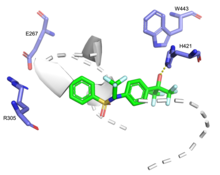Liver X receptor
UniProt | Q13133 | ||||||
|---|---|---|---|---|---|---|---|
| |||||||
UniProt | P55055 | ||||||
|---|---|---|---|---|---|---|---|
| |||||||
The liver X receptor (LXR) is a member of the
Two
LXRα and LXRβ were discovered separately between 1994-1995. LXRα isoform was independently identified by two groups and initially named RLD-1[1] and LXR,[2] whereas four groups identified the LXRβ isoform and called it UR,[3] NER,[4] OR-1,[5] and RIP-15.[6] The human LXRα gene is located on chromosome 11p11.2, while the LXRβ gene is located on chromosome 19q13.3.
Expression
While the expression of LXRα and LXRβ in various
Structure
Crystal structure of human liver X receptor β (LXRβ) forms a heterodimer with its partner retinoid X receptor α (RXRα) on its cognate element an AGGTCA direct repeat spaced by 4 nucleotides showing an extended X-shaped arrangement with DNA- and ligand-binding domains crossed. In contrast, the parallel domain arrangement of other NRs bind an AGGTCA direct repeat spaced by 1 nucleotide. The LXRβ core binds DNA via canonical contacts and auxiliary DNA contacts that enhance affinity for the response element.[8]

Crystal structure of human liver X receptor α (LXRα) also forms a heterodimer with its partner retinoid X receptor β (RXRβ). The LXRα-RXRβ heterodimer (PDB 1UHL) binds synthetic LXR oxysterol agonist T-0901317. The ligand-binding pocket predominantly consists of hydrophobic residues. The most critical residues to the binding pocket include E267, R305, H421, and W443. The binding pocket accommodates oxysterols of molecular volumes up to 400 Å3 and T-0901317 easily positions itself with a molecular volume of 304 Å3. H421 forms a hydrogen bond with T-0901317's hydroxyl head group which lowers the pKa of the H421 imidazole side chain. As a result, the imidazole side chain interacts electrostatically with π-electrons of W443's indole side chain to stabilize the active conformation of the helices.[9]
The phenyl group of T-0901317 extends toward the β-sheet side of the binding pocket and partially occupies it. The unoccupied section contains hydrophilic, polar residues E267 and R305. H421 and W443 anchor the 22-, 24-, or 27-hydroxyl group of an oxysterol to the binding pocket via hydrogen bonding and electrostatic interactions. The conformational flexibility of R305 allows it to bind the 3-hydroxyl group and stabilize an oxysterol.[9]
Activation/ligands
LXRα and LXRβ form
and GW3965.The hexacyclic aromatic ketones, (-)anthrabenzoxocinone and (-)bischloroanthrabenzoxocinone ((-)-BABX) derived from a Streptomyces sp. have micromolar affinity for LXR-α.[16]
LXR-623 (WAY 252623) CAS: [875787-07-8].
Target genes
LXR-RXR nuclear receptor heterodimers function as transcriptional regulators for genes involved in lipid metabolism, lipid homeostasis, and inflammation. including:
- ApoE – Apolipoprotein E
- CETP– CholEsterylester Transfer Protein
- FAS – Fatty Acid Synthase
- CYP7A1– CYtochrome P450 isoform 7A1 - cholesterol 7α-hydroxylase
- LPL – LipoProtein Lipase
- LXR-α – Liver X Receptor-α (a somewhat unusual example of receptor up-regulating its own expression)
- SREBP-1c– Sterol Regulatory Element Binding Protein 1c
- ChREBP– Carbohydrate Regulatory Element Binding Protein
Role in metabolism
The importance of LXRs in physiological
Adiponectin induces ABCA1-mediated reverse cholesterol transport by activation of PPAR-γ and LXRα/β.[23]
Potential therapeutic applications of LXR agonists
LXR
Cardiovascular
Treatment with LXR
Aberrant LXR signaling in macrophages due to the oxidized cholesterol 7-ketocholesterol promotes the inflammation that leads to atherosclerosis.[30] For this reason, 7-ketocholesterol is a therapeutic target for the prevention and treatment of atherosclerosis.[30]
When lipogenesis is increased by pharmacological activation of the liver X receptor, hepatic VLDL production is increased 2.5-fold, and the liver produces large TG-rich VLDL particles. Glucose induces expression of LXR target genes involved in cholesterol homeostasis like ABCA1 which is defective in Tangier disease. A common feature of many metabolic pathways is their control by retinoid X receptor (RXR) heterodimers. LXR heterodimerises with RXR. Promiscuous RXR also heterodimerises with PPAR members. PPAR-α plays a pivotal role in fatty acid catabolism in liver by upregulating the expression of numerous genes involved in mitochondrial fatty acid oxidation. Thus RXR is a common partner of two nuclear receptors acting in opposite directions with regard to fatty acid metabolism. So both LXR and PPAR-α compete for the limited pool of RXR and this dynamic equilibrium determines the direction of lipid metabolism.[31]
Developing new potent and effective LXR agonists without the undesirable side effects may be beneficial for clinical usage.[32] In this regard, DMHCA was reported to reduce atherosclerosis in apolipoprotein E-deficient mice without inducing hypertriglyceridemia and liver steatosis.[27]
Alzheimer's disease
Treatment with T0901317 decreases amyloidal beta production in an
Cancer
LXR agonists (T0901317, 22(R)-hydroxycholesterol, and 24(S)-hydroxycholesterol) were also shown to suppress the proliferation of prostate cancer and breast cancer cells[34] as well as delay progression of prostate cancer from androgen-dependent status to androgen-independent status.[35]
References
- PMID 7935418.
- PMID 7744246.
- PMID 7971966.
- PMID 7926814.
- PMID 7892230.
- PMID 7760852.
- PMID 17372849.
- S2CID 23226682.
- ^ S2CID 43844694.
- PMID 26030625.
- S2CID 4361170.
- PMID 9380679.
- PMID 9013544.
- PMID 11089551.
- PMID 11090131.
- PMID 16180833.
- PMID 12449021.
- S2CID 5856580.
- PMID 11287605.
- PMID 11090130.
- PMID 12368482.
- PMID 15738425.
- S2CID 203413137.
- PMID 11238557.
- PMID 12032330.
- S2CID 11199331.
- ^ PMID 18812595.
- PMID 12697904.
- S2CID 10356659.
- ^ PMID 31926618.
- PMID 18240340.
- PMID 21493922.
- PMID 15557325.
- PMID 15520170.
- PMID 16818617.
External links
- liver+X+receptor at the U.S. National Library of Medicine Medical Subject Headings (MeSH)
- [1] (Nuclear Receptor Resource).
